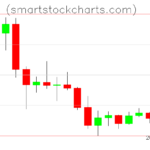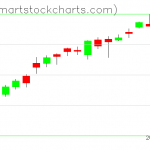5 items every good trading plan MUST contain.
5 items every good trading plan MUST contain.
 Face it, trading is a business. Every good business has a business plan, whether on paper or at least in the head of the owner. Likewise, as a trader, you’re going to be stricken with emotions whenever you’re winning or losing a ton of money and it’s easy to get sidetracked. Whether or not you believe you have multiple personalities, please assume you have 2 personalities when you’re trading: your Rational self and your Emotional self. You create your trading plan when you’re your Rational self and you use it to remind your Emotional self to stay on track whenever your elated from all the profits you’re making or deep in despair from losses.
Face it, trading is a business. Every good business has a business plan, whether on paper or at least in the head of the owner. Likewise, as a trader, you’re going to be stricken with emotions whenever you’re winning or losing a ton of money and it’s easy to get sidetracked. Whether or not you believe you have multiple personalities, please assume you have 2 personalities when you’re trading: your Rational self and your Emotional self. You create your trading plan when you’re your Rational self and you use it to remind your Emotional self to stay on track whenever your elated from all the profits you’re making or deep in despair from losses.
I recommend writing down your trading plans if you’re new to trading. Paper and pencil is fine but Evernote is recommended to keep track of your progress in a digital journal.
#1: Ask yourself: why do you need this money?
Let’s face it, you can’t eat money. Money doesn’t bring you happiness, at least not in its pure form as pieces of paper or numbers in your bank or brokerage account. Obviously, it’s the things that money can buy that’ll bring you happiness, satisfaction, or meaning in life. Money can buy goods and services like a new sports car, your child’s college education, a nice vacation, etc. but that’s just the tip of the iceberg. Money can also buy you freedom if you accumulate a nest egg of, say, at least 25x of your living expenses and invest that nest egg in a safe portfolio. You can also pay down your debts like student loans or a mortgage. You might even have a cause you’re very passionate about like animal welfare, saving the planet, etc. and wish to support it with generous donations in the future.
Money is only a resource for achieving the goals that mean the most to you in life. (What? If you don’t have many goals at all, then spend some time to find some meaningful ones with this cool exercise.) Remind yourself of the real reason behind your pursuit of money everyday when you trade and imagine the joy that the end result will bring. See money and the numbers in your brokerage accounts as merely an indicator of progress towards this goal, not the end result you’re after.
#2: Time Frame for Trades
Note: don’t confuse this with what Financial Advisors call Time Horizon: the amount of time you have before you need the money; Time Horizon is something you should have discussed with yourself in #1 when you’ve figured out the goals your money will help you achieve like retirement, a child’s education, a nice beach house, etc.
Time frame is merely the average amount of time you expect to hold the trades in your strategy. Do you want to be a scalper, holding trades for seconds or minutes? A day trader who opens and closes positions in the same day? A swing trader who holds positions for a few days to a few weeks? A position trader who holds for months or an investor who holds for years? Not all of your strategies have to be of the same time frame and it’s perfectly fine to exit a trade before its intended time, but NEVER, EVER hold on to a trade, especially a losing one, longer than the time you allotted in your trading plan! In other words, don’t ever use the popular excuse that the stock you were day trading and ended up losing money on is a good long term investment so you continue holding it for days, weeks, or even months hoping it’ll return to breakeven.
#3: How often will you check your performance
It’s true, looking at your portfolio too frequently is gonna take a psychological toll on you and you’ll be more prone to making emotional decisions that are hazardous to your wealth. But although many experts recommend only checking your portfolio once a month or less often, that’s not a practical solution for trades with a much shorter time frame. So I recommend adapting your performance evaluation to your time frame and checking your portfolio at a frame that’s 2 orders of magnitude less (see the table below):
| If your Time Frame is measured in___ | You should evaluate your performance every few ___ |
| Decades | Months |
| Years | Weeks |
| Months | Days |
| Weeks | Hours |
| Days | Minutes |
| Hours | Seconds |
| Minutes (or less) | Milliseconds (constantly) |
For example, your 401K might have a time frame that’s several decades in the future; you’ll only want to check its performance once every few months rather than constantly every few days. This is not a hard and fast rule but you may want to check your performance more frequently than what this table dictates if it’s highly volatile or especially if you’re using leverage (not recommended for beginners.)
#4: Entry/Exit Conditions in your strategy
Now we get to the “meat” of your trading or investing strategy. (Most traders who even make trading plans will only have this one section.) What are your rules for entry/exit? What technical indicators, fundamentals, and/or chart patterns do you seek to decide when to buy or sell? Is it a momentum or mean reversion based strategy? Get those rules down, preferably on paper, so you’ll have a disciplined plan to follow especially for when the going gets tough! Every time you check your strategy during the predetermined interval in #3, you should determine whether any of your entry/exit signals have come hit and execute the corresponding trade.
#5: Risk: How much are you willing to lose
This is perhaps the most important part of any trading plan but it must be done after the first 4 sections. You MUST decide the maximum amount of money you’re willing to lose on this strategy before you shut it down and move on! Many traders blow up or go broke because they didn’t have a discipline plan for getting out of a trade after they’ve lost a predetermined amount of money! You will NOT be one of THEM!!!
If the interval you’ve determined in #3 for checking your performance is longer than, say, a few days, then I recommend automating the process of exiting your trade once you’ve lost your target amount. A stop loss order is the most convenient way, but if your security is prone to big gaps between trading days, then you might want to use options to better enforce a maximum loss. This will also protect you in the event of a black swan causing unexpected and unprecedented losses for many traders taking the same position.
If your strategy involves a pairs trade or a basket of securities, then it’s a bit more difficult setting an automated exit using a stop loss or an option. In that case, you’ll have a few alternatives:
- Pick a more frequent time frame for evaluating your performance.
- Be willing to risk losing more than the amount you’ve designated here (not very likely esp if your portfolio is well diversified.)
- Use an algorithmic trading platform like Tradestation and set a threshold for terminating the strategy (beyond the scope of this article.)
Final thoughts about your trading plan
While having a trading plan is no guarantee of success for a trader, not having a plan will almost always end in disaster. Trading is like a business and while some businesses can get away with having no official business plan, traders will almost always end up succumbing to their emotions when their money is on the line. By having an effective trading plan that includes at least the 5 items I’ve outlined above, you will have the discipline to stay on the course or protect your wealth no matter what the financial markets throw at you.



